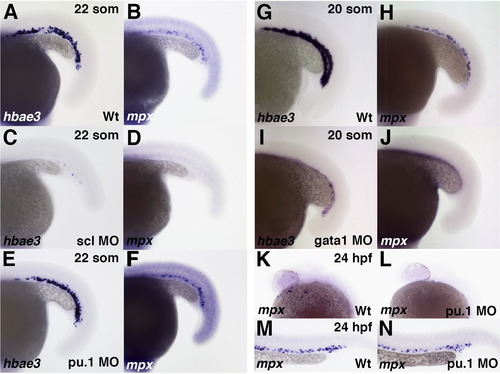Fig. 5
- ID
- ZDB-FIG-150327-5
- Publication
- Glenn et al., 2014 - Distinct regulation of the anterior and posterior myeloperoxidase expression by Etv2 and Gata1 during primitive Granulopoiesis in zebrafish
- Other Figures
- All Figure Page
- Back to All Figure Page
|
Knockdown of scl and gata1, but not pu.1, results in the loss of PLPM-specific mpx expression at the 22- and 20-somite stage. (A, B) Wild type expression of embryonic globin hbae3 (A), and mpx (B) is normal in 100% (n=23) and 61% (n=28) of control uninjected embryos, respectively, in the intermediate cell mass region at the 22-somite stage. (C and D) scl morpholino knockdown results in the loss of hbae3 (C) and mpx (D) expression in 100% (n=24) and 97% (n=32) of embryos, respectively. (E and F) Knockdown of pu.1 does not affect hbae3 expression (E, 100% of embryos, n=54), or mpx expression (F, 70% of embryos, n=37). (G and H) Wild type expression of embryonic globin hbae3 (G), and mpx (H) in the intermediate cell mass region at the 20-somite stage is normal in 100% (n=20) and 78% (n=60) of control uninjected embryos, respectively. (I and J) Knockdown of gata1 results in the loss of expression of both hbae3 (I) and mpx in 100% of embryos, n=28 and n=100, respectively (J). (K and L) mpx expression is strongly reduced or absent in the anterior of mpx morpholino knockdown embryos (L, 92% of embryos, n=25) compared to uninjected controls (K, 13% of embryos, n=8). (M and N) mpx expression is normal in the posterior of mpx morpholino knockdown embryos (N, 88% of embryos, n=25) compared to uninjected controls (M, 75% of embryos, n=8). |
| Genes: | |
|---|---|
| Fish: | |
| Knockdown Reagents: | |
| Anatomical Terms: | |
| Stage Range: | 20-25 somites to Prim-5 |
Reprinted from Developmental Biology, 393(1), Glenn, N.O., Schumacher, J.A., Kim, H.J., Zhao, E.J., Skerniskyte, J., Sumanas, S., Distinct regulation of the anterior and posterior myeloperoxidase expression by Etv2 and Gata1 during primitive Granulopoiesis in zebrafish, 149-59, Copyright (2014) with permission from Elsevier. Full text @ Dev. Biol.

